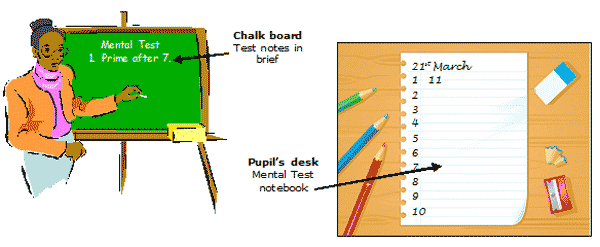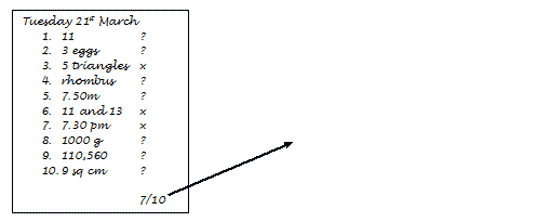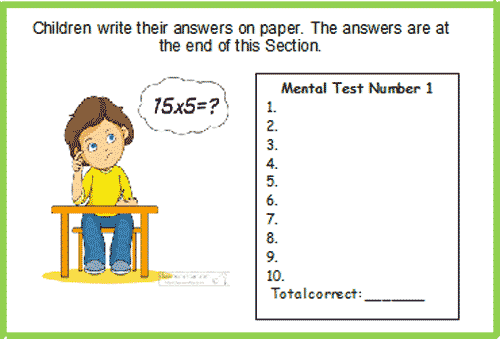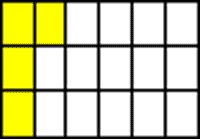Mental maths
The ability to give a good mental test is a skill which teachers should learn. At first your tests should be written down. Keep them in a file so that you can use them again. Make them interesting by making some of the questions into little stories. This will help the children with their listening and language skills as well as their problem solving skills.
Introduction
Children should learn to do addition, subtraction, multiplication and division by their own methods and in their head. This is a very important skill for children to carry with them into life. ‘Mental methods’ enable us to quickly add up the price of stamps in the post office or to multiply the number of chairs at a church gathering. They also help us in the important skill of estimation.
The ability for children to do mental arithmetic gives them a freedom from using pencils, pens, paper and other expensive resources. It is a powerful tool which will be available at all times. Mental arithmetic can also act as a warm-up session at the beginning of the day or before a mathematics lesson. Nowadays we extend the term mental arithmetic to Mental Maths because many of the questions are not just on arithmetic (number work) but include work on shapes, measurement and geometry.
Testing
We often appraise the ability of being able to do mental mathematics in the form of a mental test. This gives an opportunity to arrange a staff meeting to discuss testing as a teaching activity.
Mental test notebooks
Each pupil should be given, or they should buy, a small exercise book. These can be prepared, by the pupils, by letting them write the numbers from 1 to 10 on several pages. In this way they are prepared to work on the test as soon as the teacher wishes, without wasting time.

Examples:
Lower Primary level
- I bought a bag of 8 sweets and eat 3 of them. How many did I have left?
- Write the number which is 2 more than 15.
- If it is 12 o’clock, what time would it be in one hour?
- A chicken was sitting on 9 eggs. A rat stole 2 of them. How many were left?
- On a number line, which number is 3 bigger than 7?
- Two children place their hands on the desk. How many fingers are on the desk?
- How many sticks are there in 2 bundles with 10 sticks in each bundle?
- How many corners are there in a square?
- How many stones altogether are there in a group of 10 stones and a group of 3 stones?
- What is 2 plus 2 plus 2 minus 2?
Upper Primary level
- What is the difference between the two values of 6 in the number 7366?
- Marie scored 8, 7 and 9 goals in three netball matches. How many goals did she score altogether?
- What is the difference between 5 times 20 and 2 times 50?
- What is the time a quarter of an hour after 11.50 am?
- How many millimetres in a quarter of a metre?
- Today is the eighth of the month. What will the date be in one week’s time?
- A reel of cotton contains 200 m. Mother used 5 reels of cotton. How many kilometres did she use?
- Multiply 9 x 4. How many sixes are in the product?
- What is the sum of the even numbers less than 10?
- One side of a rectangular garden is 40 m and the other side is 60 m long. What is the perimeter of the garden?
Marking the tests
When the pupils have written the answers to your test they should change their books for marking. Pupils plot their marks onto their own graph which is drawn at the end of their mental arithmetic book.
| No | Date | |||||
| 21/6 | 22/6 | 23/6 | 24/6 | 25/6 | ||
| 10 | ||||||
| 9 | ||||||
| 8 | ||||||
| 7 | ||||||
| 6 | ||||||
| 5 | ||||||
| 4 | ||||||
| 3 | ||||||
| 2 | ||||||
| 1 | ||||||
| 0 | ||||||

Getting the whole school to work together in improving mental mathematics:
- Have something to give to new members of staff so that they feel involved as members of the team.
- All teachers and pupils contribute to a materials bank.
- Make sure that the whole staff is together on a mental maths policy.
- Have frequent mathematics meetings where mental tests and other test questions are discussed and noted.
- All testing and exams are controlled by members of staff.
- Form a small panel of teachers especially interested in the teaching of mathematics. They will lead mathematics meetings.
Mental maths that we can work out ‘in our head,’ is a very important life skill.
Here are some tests you can give to the children:

Test 1
- Add ten thousand and three to one thousand and fourteen.
- 9001 - 2 =
- 111 x 11 =
- 12, 018 ÷ 6 =
- A bag of 60 oranges costs 36 units. What is the price of 45 oranges?
- In a certain Grade 6 class 3/8 of the pupils are boys. If 2/3 of these boys like mathematics, what fraction of the pupils are boys who like mathematics?
- David is twice as old as his sister Joyce. Their ages together come to 27 years. How old is Joyce?
- What fraction of the rectangle is shaded (in its lowest terms)?

- Write a quarter of a million as a number.
- 1/3 of a bag of sweets was given to a teacher who gave 1/5 of these sweets to her son. The son received 2 sweets. How many sweets were in the bag at the beginning?
Test 2
- Add hundred and one thousand and one to one thousand and eleven.
- Find the value of the two fours in the number 14 748 and take them away from each other.
- Write the number 13 030 in words.
- 11, 010 - 1 =
- (1010 x 10) ÷100 =
- 50,020 ÷ 5 =
- 12 kg of nails cost 66 units. What is the price of 8 kg of nails?
- 80 apples cost 32 units. What would 56 apples cost?
- In a Grade 1 class, 2/5 of the pupils can read. 1/4 of those who can read are boys. What fraction of the class are girls that can read?
- Mary has twice as many sweets as Joyce. Greta has 12 sweets and has twice as many sweets as Mary. How many sweets does Joyce have?
Test 3
- What number is one hundred more than 2,964?
- Take one thousand from half a million.
- What is the third multiple of 9?
- What fraction of the word 'SCISSORS' is taken up by the letter 'S'?
- What number is ten times bigger than 33?
- From these heights, select which is the nearest to the height of your teacher: 78cm; 1.16m; 1.77m; 2.52m; 3.25m.
- From these weights select do you think is the probable weight of your teacher? 95g; 968g; 14kg; 82kg; 265kg.
- Which is the smallest fraction here? 7/8; 1/2; 1/3; 4/9; 7/10; 5/12.
- Which is the largest decimal here? 0.1; 0.001; 0.201; 0.093; 0.1234; 0.09.
- What is the next prime number after 19?
Test 4
- What fraction of the rectangle is shaded (lowest terms)?

- Write a fifth of ten thousand as a number.
- A teacher took 3/4 of the Science books home to mark. She only marked 1/2 of those she took home. If there were 48 children in the class, how many books did she mark?
- A car is offered in a sale with 10% off its original price. The sale price of a car is 45 000 units. What was its price before the sale?
- From the heights below select which one is nearest to the height of your classroom door: 1 m; 2 m; 3 m; 4 m; 5m
- From these areas, select those nearest to the area of your classroom: 600 sq cm; 6000 sq cm; 6 sq m; 60 sq m; 600 sq m.
- Which is the lightest weight? 0.005 kg; 50 g; 1/5 kg; 0.05 kg; 15.5 g
- Which is the longest period of time? 660 sec; 6 min; 0.6 h; 0.6 min; 1/6 h
- 1/4 x M = 2 x 6. What is the value of M?
- How many metres of fencing would be needed to go round a rectangular garden measuring 75m x 15m?
Test 5
- Add twenty three thousand and forty to three thousand and sixty.
- Take five from fifty thousand.
- What is a third of a half of 54?
- What is the next prime number after 23?
- If a square has one side of 12 cm, what is its perimeter?
- Your school's sprint champion would probably run the 100 metre race in: 11.5 seconds; 23 seconds; 40 seconds; 1 minute; 1 hour ?
- How many grams are in 4.38 kg?
- The largest angle of an isosceles triangle is 72 degrees. What is the size of one of the other two angles?
- Which is the longest length?
a) A thousand centimetres?
b) Five thousand millimetres?
c) A tenth of a kilometre?
d) A hundred and ten metres? - How many hundreds are there in 25,000?
Test 6
- What fraction of the rectangle is shaded (lowest terms)?

- What is a fifth of a half?
- A teacher marked 1/3 of the Form 4 Mathematics books at school, and she took the rest home. She managed to mark 1/2 of those she took home. She then had 14 books left to mark. How many pupils are there in Form 4?
- A bucket of sand weighed 24 kg, but when it was wet it weighed 50% more. What was the weight of the bucket of sand when wet?
- A textbook cost 35 units for one, but the manager gave a 10% discount for any quantity over five books. How much did ten books cost?
- A square has an area of 64 square metres. What is the perimeter of this square?
- Which is the longest period of time? 6000 seconds; 60 minutes; 1/6 hour; 6.666 minutes.
- A ball of string is 12 metres long. 2.36 metres are used. How much is left?
- If a = 6 and b = twice as much as a, what would b x (a + b) equal?
- How many squares can you see in this shape?


 |
 |
 |